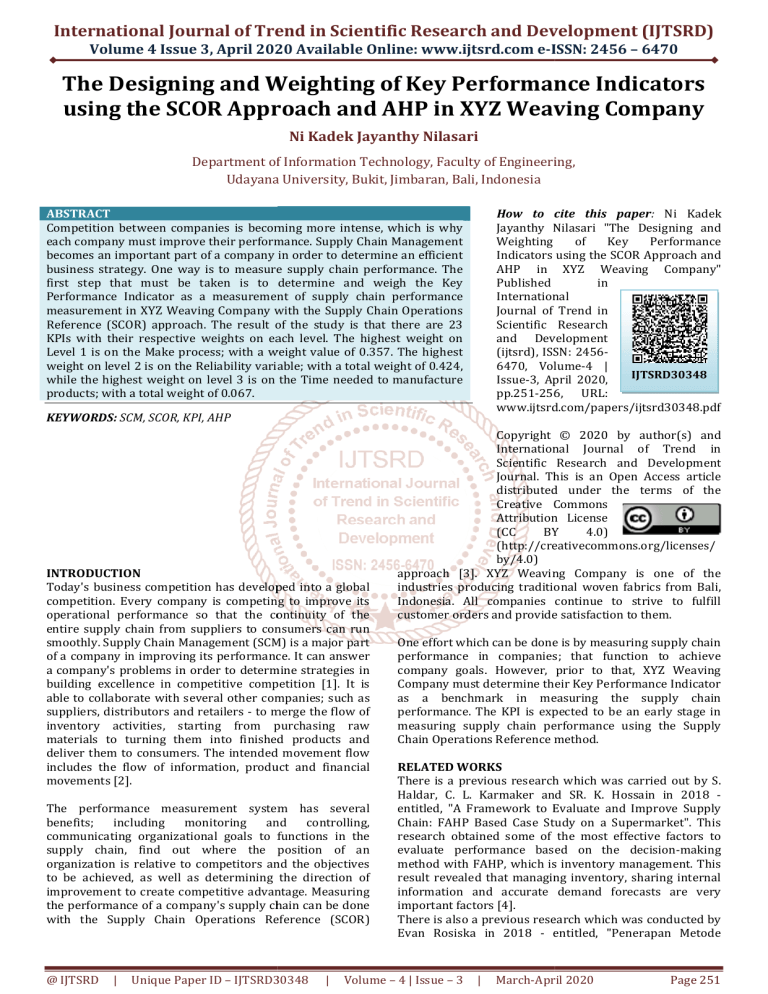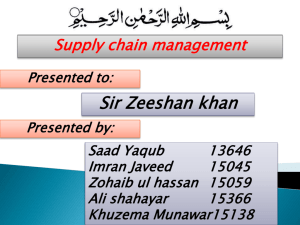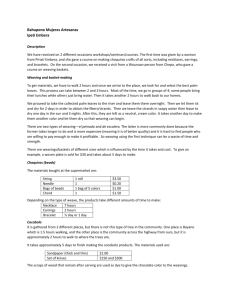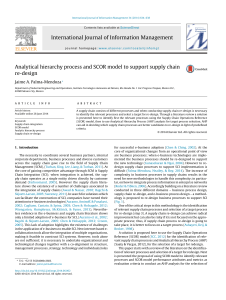
International Journal of Trend in Scientific Research and Development (IJTSRD)
Volume 4 Issue 3, April 2020 Available Online: www.ijtsrd.com e-ISSN:
ISSN: 2456 – 6470
The Designing and
nd Weighting of Key Performance Indicators
using the
he SCOR Approach and AHP in
n XYZ Weaving Company
Ni Kadek Jayanthy Nilasari
Department off Information Technology, Faculty of Engineering,
neering,
Udayana University, Bukit
Bukit, Jimbaran, Bali, Indonesia
ABSTRACT
Competition between companies is becoming more intense, which is why
each company must improve their performance. Supply Chain Management
becomes an important part of a company in order to determine an efficient
business strategy. One way is to measure supply chain performance. The
first step that must be taken is to determine and weigh the Key
Performance Indicator as a measurement of supply chain performance
measurement in XYZ Weaving Company with the Supply Cha
Chain Operations
Reference (SCOR) approach. The result of the study is that there are 23
KPIs with their respective weights on each level. The highest weight on
Level 1 is on the Make process; with a weight value of 0.357. The highest
weight on level 2 is on the Reliability variable; with a total weight of 0.424,
while the highest weight on level 3 is on the Time needed to manufacture
products; with a total weight of 0.067.
How to cite this paper: Ni Kadek
Jayanthy Nilasari "The Designing and
Weighting
of
Key
Performance
Indicators using the SCOR Approach and
AHP in XYZ Weaving Company"
Published
in
International
Journal of Trend in
Scientific
ic Research
and Development
(ijtsrd), ISSN: 24562456
6470, Volume-4
Volume
|
IJTSRD30348
Issue-3,
3, April 2020,
pp.251-256,
256, URL:
www.ijtsrd.com/papers/ijtsrd30348.pdf
KEYWORDS: SCM, SCOR, KPI, AHP
INTRODUCTION
Today's business competition has developed into a global
competition. Every company is competing to improve its
operational performance so that the continuity of the
entire supply chain from suppliers to consumers can run
smoothly. Supply Chain Management (SCM) is a major part
of a company in improving its performance. It can answer
a company's problems in order to determine strategies in
building excellence in competitive competition [1]. It is
able to collaborate
llaborate with several other companies; such as
suppliers, distributors and retailers - to merge the flow of
inventory activities, starting from purchasing raw
materials to turning them into finished products and
deliver them to consumers. The intended mov
movement flow
includes the flow of information, product and financial
movements [2].
The performance measurement system has several
benefits;
including
monitoring
and
controlling,
communicating organizational goals to functions in the
supply chain, find out where the position of an
organization is relative to competitors and the objectives
to be achieved, as well as determining the direction of
improvement to create competitive advantage. Measuring
the performance of a company's supply chain can be done
with the Supply Chain Operations Reference (SCOR)
@ IJTSRD
|
Unique Paper ID – IJTSRD30348
30348
|
Copyright © 2020
20
by author(s) and
International Journal of Trend in
Scientific Research and Development
Journal. This is an Open Access article
distributed under the terms of the
Creative Commons
Attribution License
(CC
BY
4.0)
(http://creativecommons.org/licenses/
by/4.0)
approach [3]. XYZ Weaving Company is one of the
industries producing traditional woven fabrics from Bali,
Indonesia. All companies continue to strive to fulfill
fulfi
customer orders and provide satisfaction to them.
them
One effort which can be done is by measuring supply chain
performance in companies; that function to achieve
company goals. However, prior to that, XYZ Weaving
Company must determine their Key Performance Indicator
as a benchmark in measuring the supply chain
performance. The KPI is expected to be an early stage in
measuring supply chain performance using the Supply
Chain Operations Reference method.
RELATED WORKS
There is a previous research which was carried out by S.
Haldar, C. L. Karmaker and SR. K. Hossain in 2018 entitled, "A Framework to Evaluate and Improve Supply
Chain: FAHP Based Case Study on a Supermarket". This
research obtained some of the most effective factors to
evaluate performance based on the decision-making
decision
method with FAHP, which is inventory management. This
result revealed that managing inventory, sharing internal
information and accurate demand forecasts are very
important factors [4].
There is also a previous research which was conducted by
Evan Rosiska in 2018 - entitled, "Penerapan
"Pen
Metode
Volume – 4 | Issue – 3
|
March-April
April 2020
Page 251
International Journal of Trend in Scientific Research and Development (IJTSRD) @ www.ijtsrd.com eISSN: 2456-6470
Analytical Hierarchy Process (AHP) dalam Menentukan
Mitra Usaha Berprestasi". This research contained ways to
determine business partners who excel with the AHP
method. The result showed that TT travel is on the first
rank (32%), Celebes is on
n the second rank (22%), Putri
Persada is on the third rank (17%), Lucia is on the fourth
rank (15%), and Filkana is on the fifth rank (11%) [5].
Furtheremore, there is a previous research which was
conducted by Adnan Aktepe and Suleyman ERSOZ in 2011
– entitled,
ntitled, "A Fuzzy Analytic Hierarchy Process Model for
Supplier Selection and A Case Study". This research
discussed multi-criteria
criteria decision making with the Fuzzy
Analytic Hierarchy Process method in the field of Supply
Chain Management [6].
RESEARCH METHOD
The flow of research that includes the steps undertaken in
this study can be seen in Figure 1.
2. Measurement of Supply Chain Performance
Supply chain performance is defined as the ability of the
supply chain to deliver the right product to the right
location at the right time; with the lowest logistics costs.
This definition takes into account the delivery time, cost,
as well as the value for the final consumer. The
measurement of supply chain performance covers the
most important aspects of supply chain [7]. There are
three basic criteria for performance evaluation [8], which
are:
2.1. Success, which is the relationship between the results
and goals achieved.
hieved. This is related to the level of
customer satisfaction in relation to the resources
made to achieve the goals.
2.2. Efficiency, which is the relationship between the effort
and resources involved in operations and the actual
utility value as a result of actions. This is related to
achieving goals at lower costs.
2.3. Effectiveness,
ffectiveness, which is related to satisfaction with the
result that have been achieved.
3. Supply Chain Operations Reference
The Supply Chain Operation Reference (SCOR) model was
created in 1997 by a coalition of a large number of
logistics organizations and practitioners. They established
a supply chain board to analyze the phenomenon in terms
of its management from a global and inter-organizational
inter
perspective. Their purpose is to provide a conceptual
concep
tool
to increase the effectiveness of supply chain operations
that can be used by business partners in their trade.
Fig.1.
1. Research Methodology
Figure 1 represents the stages of the research process
from the analysis of the SCOR method approach to
measure the performance of a company's supply chain
chain.
THEORETICAL FRAMEWORK
Literature review contains supporting theories in the
research to be conducted. These theories include SCM,
SCOR, Measurement of Supply Chain Performance, and
AHP.
1. Supply Chain Management
Supply
ply Chain Management (SCM) is a major part of a
company in improving its performance. It includes several
parties working together to collaborate on creating
strategies and increasing the efficiency of the company's
operational performance. It can answer a company's
problems in order to determine strategies in building
excellence in competitive competition [1]. It is able to
collaborate with several other companies; such as
suppliers, distributors and retailers - to merge the flow of
inventory activities, starting
tarting from purchasing raw
materials to turning them into finished products and
deliver them to consumers. The intended flow of
movement includes the flow of information, product and
financial movements [2].
@ IJTSRD
|
Unique Paper ID – IJTSRD30348
30348
|
The SCOR model applies traditional business processes in
an inter-organizational
organizational environment to describe all
interactions which occur in logistic or production value
chains that result from the return of goods or defective
goods [9]. The SCOR model helps to create a shared vision
in management and manage five main supply chain
processes; which consist of plan, source, make, deliver and
return [10].
4. Five Core Processes in the SCOR Model
The SCOR model divides supply chain processes into five
core processes; which are plan, source, make, deliver and
return. An overview of core processes in the SCOR Model
can be seen in Figure 2.
Fig.2. Five Core Processes in the SCOR Model
The SCOR model has been developed to describe business
activities related to all phases in its purpose to fulfill
customers' demand. The model itself contains several
parts and is composed of five main management
processes;
esses; which are Plan, Source, Make, Deliver and
Return. SCOR also has 5 performance attributes, which are
Reliability, Responsiveness, Agality, Cost, and Assets.
Volume – 4 | Issue – 3
|
March-April
April 2020
Page 252
International Journal of Trend in Scientific Research and Development (IJTSRD) @ www.ijtsrd.com eISSN: 2456-6470
5. Analytic Hierarchy Process
Analytic Hierarchy Process (AHP) is a process which helps
decision-makers to obtain the best solution by
decomposing complex problems into simpler forms and
synthesizing the various factors involved in the issue of
decision making. It considers the qualitative and
quantitative aspects of a decision and reduces the
complexity of a decision by making one-on-one
comparisons of the various criteria chosen, to process and
obtain the results later. This technique not only helps
decision-makers to obtain the best alternative solutions,
but it also provides a clear rational understanding of the
choices made [11].
RESULT AND DISCUSSION
1. SCM Business Process
The first stage is to identify the supply chain flow in the XYZ Weaving Company, which is useful to find the Key
Performance Indicator to be analyzed.
Fig.3.SCM Business Process in the XYZ Weaving Company
The business processes of X Weaving Company are described by an analysis of four types of supply chain management
flow; which are the flow of information, finance, material and return material - to determine the Key Performance
Indicator
2. Key Performance Indicator Identification
Key Performance Indicators to be measured can be seen in Table 1. The following Key Performance Indicators are
obtained from an analysis of business processes in the XYZ Weaving Company.
Table1. KPI Determination Result
Core
Processes
(Level 1)
Plan
Performance
Attributes
(Level 2)
Reliability
Responsiveness
Assets
Reliability
Source
Responsiveness
Flexibility
Assets
Reliability
Make
Responsiveness
Deliver
Reliability
Number
of KPI
Key Performance Indicator
(Level 3)
1
2
3
4
5
6
7
8
9
10
11
12
13
14
15
16
17
Estimated accuracy of raw materials
The amount of meetings with suppliers
The time needed to identify new products
The time needed to draw up a production schedule
Cash to cash cycle time
Percentage of accuracy of the amount of raw materials sent by suppliers
The amount of raw materials that are free from defects
The amount of raw materials that are undamaged during the shipping process
The time needed to publish the purchase order
The time needed to receive raw materials from suppliers
Suppliers availability
Daily supplies
Suitability in fulfilling production targets
The number of defective products during the production process
The time needed to manufacture products
The speed in responding to a variety of customer orders
Percentage of accuracy of delivery goods to consumers seen from the item
Percentage of the accuracy of shipping goods to consumers seen from the
quantity
Delivery performance in accordance with the predetermined time
The time needed since the demand until the goods are received by consumers.
The speed in responding to sudden delivery requests
The number of complaints from consumers
The time needed to resolve complaints from consumers
18
Responsiveness
Return
@ IJTSRD
Reliability
Responsiveness
|
19
20
21
22
23
Unique Paper ID – IJTSRD30348
|
Volume – 4 | Issue – 3
|
March-April 2020
Page 253
International Journal of Trend in Scientific Research and Development (IJTSRD) @ www.ijtsrd.com eISSN: 2456-6470
3. Weighting with the AHP method
Weighting is done to determine the weight of each matrix. The result from weighting is obtained from the questionnaire
assessment of respondents who know the condition of the company best.
Table2. Pairwise Comparison Matrix
Proses Plan Source Make Deliver Return
Plan
1
2
1/2
1
1
Source 1/2
1
1/2
2
3
Make
2
2
1
3
3
Deliver
1
1/2
1/3
1
1
Return
1
1/3
1/3
1
1
Table 2 outlines the result of the pair wise comparison matrix on SCOR Level 1. On this stage, a comparison assessment is
performed between one criterion with the other criteria.
Proses
Plan
Source
Make
Deliver
Return
Total
Table3. Normalization To Find Out The Priority Weight
Plan
Source
Make
Deliver Return Total Priority Weight
0,182
0,34
0,19
0,13
0,11
0,95
0,194
0,091
0,17
0,19
0,25
0,33
1,03
0,206
0,364
0,34
0,38
0,38
0,33
1,79
0,357
0,182
0,09
0,12
0,13
0,11
0,63
0,125
0,182
0,06
0,12
0,13
0,11
0,60
0,118
1
1
1
1
1
5,00
Table 3 is the normalization result of pair wise comparison matrix. After finding out the normalization of each cell, each
column is then added up to determine the weight of each criterion by means of the sum of each column divided by the total
rows. To find out whether the matrix is consistent, the matrix consistency test is calculated afterwards. The next step is to
test the consistency of the weight that has been obtained
3.1.
3.2.
Finding the value of [A] = matrix x priority weight
Matrix
Priority Weight
1
2
0,5
1 1
0,190
0,5
1
0,5
2 3
0,207
2
2
1
3 3 X
0,358
1
0,5
0,333 1 1
0,126
1 0,333 0,333 1 1
0,120
[ ]
Finding the Vector B =
Vector B
=
=
3.3.
=
Vector [A]
1,03
1,09
1,89
0,66
0,62
1,03
0,190
5,42
1,09
0,207
5,28
1,89
0,358
5,27
0,66
0,126
5,23
0,62
0,120
5
Finding the Maximum Eigenvalue
MEV =
5,42 + 5,28 + 5,27 + 5,23 + 5
5
= 5,28
=
3.4. Finding the Consistency Index
CI =
=
5,28 − 5
5−1
= 0, 07
3.5. Finding the Value of Random Consistency Index (RI)
For N = 5, then the value of Random Consistency Index = 1,12
@ IJTSRD
|
Unique Paper ID – IJTSRD30348
|
Volume – 4 | Issue – 3
|
March-April 2020
Page 254
International Journal of Trend in Scientific Research and Development (IJTSRD) @ www.ijtsrd.com eISSN: 2456-6470
3.6. Finding the Consistency Ratio
CR =
0,07
=
1,12
= 0,006
Based on the calculations made throughout the entire Plan, Source, Make, Deliver and Return process; it is found that the
Maximum Eigen Value is 5.03 - with a Random Consistency Index (RI) of 1.12 and a Consistency Index (CI) of 0.01. By
using the CI / IR formula, a Consistency Ratio (CR) of 0.006 is obtained, where the value ≤ 0.1 indicates that the data used
are consistent and can be justified to do the calculations. KPI weighting can also be done using Expert Choice software. The
result of data processing in the Expert Choice software can be seen in Figure 4.
Fig.4. Weighting through Expert Choice Software
Figure 4 shows the weighting result from the SCOR core processes with consistent result. KPI weighting on level 2 and 3
are also carried out using Expert Choice software. The result of all the weights can be seen in Table 4.
Core Processes (Level 1)
Plan
Source
Make
Deliver
Return
Table4. Kpi Weight Value on Level 1, 2 And 3
Weight Performance Attributes (Level 2)
Weight
0,194
0,206
Reliability
0,062
Responsiveness
0,054
Assets
0,046
Reliability
0,082
Flexibility
Assets
0,064
0,044
Reliability
0,119
Responsiveness
0,130
Reliability
0,104
Responsiveness
0,110
Reliability
Responsiveness
0,057
0,041
0,357
0,125
0,118
Based on the result of weighting by using the AHP method;
the highest value on Level 1 is obtained, which is on the
Make process - with a weight value of 0.357. This is
because X Weaving Company considers the production
process as the process that most determines the quality of
the product. If the production goes well, the quality and
quantity of the product produced will be good. On level 2,
the Responsiveness attribute of the Make process
@ IJTSRD
|
0,086
Responsiveness
Unique Paper ID – IJTSRD30348
|
KPI (Level 3)
1
2
3
4
5
6
7
8
9
10
11
12
13
14
15
16
17
18
19
20
21
22
23
Weight
0,023
0,020
0,024
0,031
0,033
0,038
0,043
0,037
0,034
0,045
0,028
0,034
0,066
0,065
0,067
0,051
0,062
0,061
0,066
0,051
0,043
0,039
0,039
obtained the highest value; with a weight value of 0.130.
This is because X Weaving Company considers the speed
of the production process can increase consumer
satisfaction. On level 3, KPI of The time needed to produce
the product obtained the highest value; with a weight
value of 0.067. This is because X Weaving Company
receives many orders every day, so that a fast production
process is needed.
Volume – 4 | Issue – 3
|
March-April 2020
Page 255
International Journal of Trend in Scientific Research and Development (IJTSRD) @ www.ijtsrd.com eISSN: 2456-6470
CONCLUSION
Based on the result of weighting by using the AHP method;
the highest value on Level 1 is obtained, which is on the
Make process - with a weight value of 0.357. This is
because X Weaving Company considers the production
process as the process that most determines the quality of
the product. If the production goes well, the quality and
quantity of the product produced will be good. On level 2,
the Responsiveness attribute of the Make process
obtained the highest value; with a weight value of 0.130.
This is because X Weaving Company considers the speed
of the production process can increase consumer
satisfaction. On level 3, KPI of The time needed to produce
the product obtained the highest value; with a weight
value of 0.067. This is because X Weaving Company
receives many orders every day, so that a fast production
process is needed.
REFERENCES
[1] Zaroni, Logistics & Supply Chain, Konsep Dasar
Logistik Kontemporer Praktik Terbaik. Jakarta:
Prasetya Mulya Publishing, 2017.
[2] D. Bowersox, D. Closs, and M. B. Cooper, Supply Chain
Logistics Management, 4th ed. McGraw-Hill, 2013.
[3] I. N. Pujawan and Mahendrawathi, Supply Chain
Management, Edisi 3. Yogyakarta: Andi, 2017.
[4] S. Haldar, C. L. Karmaker, and S. R. K. Hossain, “A
Framework to Evaluate and Improve Supply Chain :
@ IJTSRD
|
Unique Paper ID – IJTSRD30348
|
FAHP Based Case Study on a Supermarket,” vol. 7, no.
4, pp. 423–440, 2018.
[5] E. Rosiska, “Penerapan Metode Analitycal Hierarchy
Process (AHP) dalam Menentukan Mitra Usaha
Berprestasi,” J. RESTI (Rekayasa Sist. dan Teknol.
Informasi), vol. 2, no. 2, pp. 479–485, 2018.
[6] A. Aktepe and S. Ersoz, “Supplier selection and a case
Study,” Int. J. Res. Dev., vol. 3, no. 1, pp. 33–36, 2011.
[7] H. Zhang and S. C. Okoroafo, “Third-Party Logistics
(3PL) and Supply Chain Performance in the Chinese
Market: A Conceptual Framework,” Eng. Manag. Res.,
vol. 4, no. 1, pp. 38–48, 2015.
[8] D. Estampe, Supply chain performance
evaluation models. London: ISTE, 2014.
and
[9] A. Lockamy and K. McCormack, “Linking SCOR
planning practices to supply chain performance: An
exploratory study,” Int. J. Oper. Prod. Manag., vol. 24,
no. 12, pp. 1192–1218, 2004.
[10] Supply Chain Council, “Supply Chain Operations
Reference Model Rev. 10.0,” Supply Chain Oper.
Manag., pp. 1–976, 2010.
[11] D. I. Sensuse and F. R. Sari, “Penerapan Metode
Analytic Hierarchy Process Dalam Sistem Penunjang
Keputusan Untuk Pemilihan Asuransi,” J. Sist. Inf.,
vol. 4, no. 2, p. 100, 2012.
Volume – 4 | Issue – 3
|
March-April 2020
Page 256





